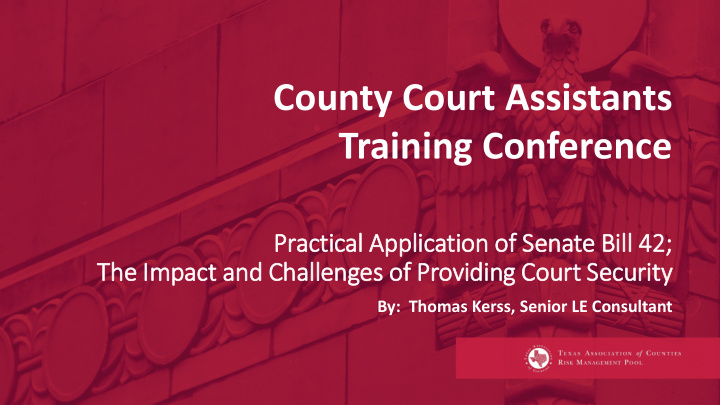



County Court Assistants Training Conference Practical Appl pplication o n of Sen enate B Bill ill 42; 2; The I Impact and C nd Cha hallen enges s of Providing g Cou ourt rt S Secu curi rity y By: Thomas Kerss, Senior LE Consultant
Learning Objectives: • Meeting local requirements • Impact on funding and implementation • Conflicting challenges to providing security Presented by: Retired Sheriff Thomas Kerss, Senior Law Enforcement Consultant Texas Association of Counties
Target Ar Areas For r Today’s T Training: Funding Security Security Security Measures Plan Personnel Personal and Training Safety
Security Provisions i in SB 42 Ap Applies to all types and levels o of local court rts: Specialty Civil Criminal Family Courts Appellate District County Justice Municipal
SB 42 a amended T TX Gov. C . Cod ode S Sec. 7 ec. 74.0 .092 t to o require a secu curity c committee be form rmed, c , consisting o of: Commissioner Administrative Court Sheriff District Judge Representative Representative District or Any other from all other County person deemed County Courts Attorney necessary
Rol ole of of Th The Se Security C Com ommit ittee: • Adopt security policies and procedures for the courts • Recommend resources and uses of money to the county commissioners’ court for courthouse security May not direct the assignment of those resources or the expenditure of those funds
SCREENING PERSONNEL AND EQUIPMENT • If so, where, Screening when and how Stations • Alarms, cameras, Technology warning systems • General fund, Budget security fee fund Funding
ANALYZI ZING NG S SECURI RITY M Y MEASURE RES Security considerations and limitations comes down to answering a few basic questions: Funding Availability vs. Costs of Security Measures • Potential Threats vs. Likelihood and Severity • Restrictions of Law • Inconvenience vs. Necessity • Example: TSA Type Security Measures vs. High Profile Trial Increases
Court S t Sec ecurity ty Plan ans a and M Meas easures es • County size influences availability of resources. • Economic status effects budgeting ability for security. • Facility design impacts security decisions and restricts areas where weapons may be banned. “A state agency or a political subdivision of the state may not provide notice by a communication described by Section 30.06, Penal Code.”
For years c s coun unties r es rel elied ed on S n Section 46-Penal C Code f for legal authority to secure o our c r court rthouses. . 46.03 Prohibits firearms and other weapons: • at polling places during voting • on the premises of any government court, or • In offices utilized by the court 46.035 Prohibited firearms and other weapons: • at a correctional facility • where an open meeting of a governmental entity is held
Rec ecent l leg egislatio ion, cou ourt rulin lings an and A AG op opin inio ions al altered that. . KP-0047 d 0047 define ned d Section 4 411. 1.209 209-Gov. C Code a e as: s: “ Premises of a government court” • a structure utilized by a court, or • a courtroom or portion of such a structure . “Office utilized by the court” • those offices essential to the operation of a court.
Accordin ing t to Texas a attor orney g gener eral K Ken en P Paxton on, Opinion No. KP-0047 Firearms may be excluded from portions of buildings containing courts or offices utilized by the courts Firearms can only be banned from rooms used for Commissioners’ Court meetings when a public meeting is being held —and not in the entire building.
Li Lice censed t to C o Carry a and Open C Carry y Impa mpact = If I can’t ’t s stop o one, , I can’t ’t s stop t the o other.
Cou ourt S rt Sec ecuri rity ty P Per ersonnel el T Training
SB B 42 42 Officer T Trai aining Challen enges es C Course e 10999 10999 Requires any Court Security Officer to complete: • within one year of assignment to that position • 8-16 hours in length Court Security Officers include: • constables, sheriffs, sheriff's deputies, municipal peace officers • any other person assigned to provide security for an appellate, district, statutory county, county, municipal, or justice court.
What Can Can You Do t to S Stay Safe? The Individual Perspective
Threats Co Come In Multiple F For orms Physical Attacks: Facilities Attacks: • Assault/Active Shooter • Fire/Explosive/Combustibles • Domestic Relations Matters • Vehicle Crashes • Inmate Attacks or Escape • Burglary/Theft/Criminal Attempts Mischief • Chemical/Biological • Records/Data Intrusions Hazards
Ease a e and P Purpos ose e vs Probability • The easier an attack is to carry out the more likely the risk of occurrence. • Motivation for an attack may also drive the attack method. • Lone gunman type assaults have become more common. Weapons/ammo are easily obtained and attacks take less preparation to carry out.
Training and Preparing • Be proactive, devise a mental plan. • Gather and store basic safety items and emergency supplies. Seek First-Aid training. • Identify emergency exits and locations of safety equipment. • Train and conduct drills to minimize confusion and reduce casualties.
If a a Th Threatening I Inci cident O t Occu ccurs : • Act quickly, initiate your emergency response plan. • Evacuate if possible. • If evacuation is not possible, shelter in safe rooms. • Secure doors and windows, barricade in a safe location . • Arm yourself with any means available and be mentally prepared to defend yourself to survive.
QUESTIONS
Law E Enfor orcement t Con onsult ltants Northwest Gary Henderson (512) 968-8407 Northeast Northwest garyh@county.org Northeast Thomas Kerss (512) 589-3922 thomask@county.org Southwest David Whitis (512) 517-2547 davidw@county.org Southeast Southeast Southwest Terry Pickering (512) 517-7197 terryp@county.org
Recommend
More recommend